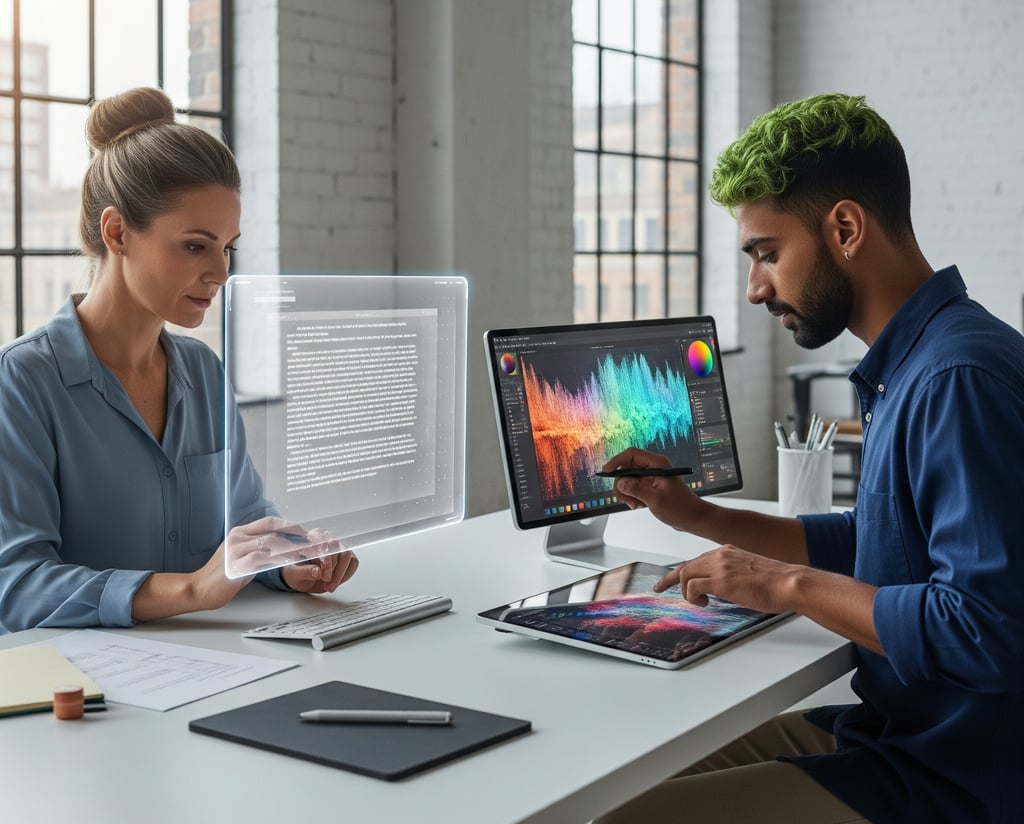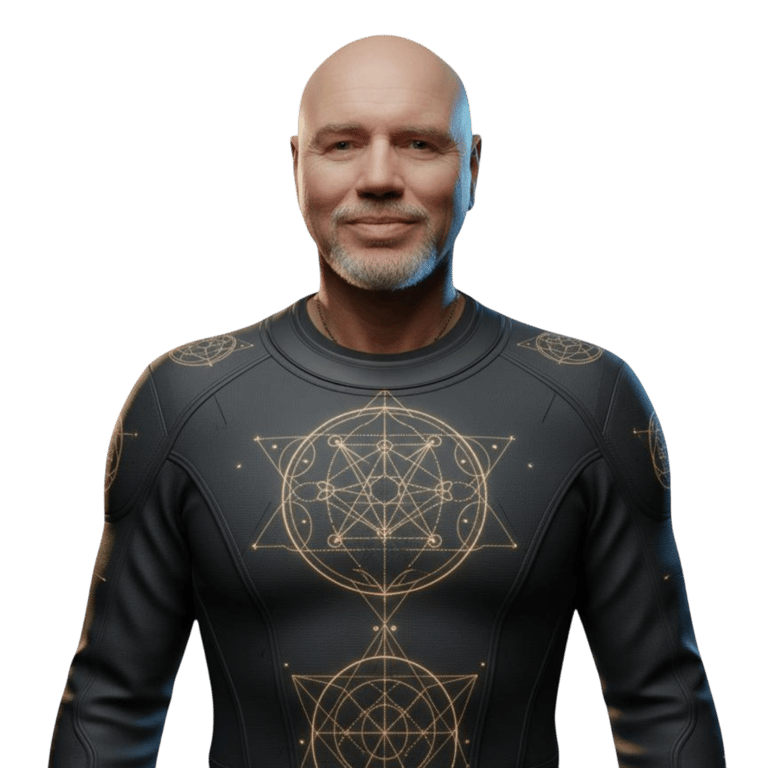The Muse in the Machine: AI as Partner in Art and Storytelling
Imagine a world where your thoughts take shape before you even finish them. For today's writers and artists, this isn't science fiction—it's the reality of working with artificial intelligence. Far from replacing human creativity, AI is opening up entirely new dimensions of artistic expression.
A.I
Nigel John Farmer
6/15/20254 min read


The collaboration between human ingenuity and artificial intelligence (AI) is revolutionizing the arts, particularly in writing and digital art. AI isn't a substitute for the artist; rather, it's a powerful tool that amplifies human creativity, streamlines the creative process, and unlocks unprecedented possibilities.
However, the heart of impactful storytelling and artistry lies in uniquely human qualities: imagination, emotional depth, and intentional curation. These ensure that AI enhances, rather than dictates, the creative journey. This exploration delves into how writers and digital artists are harnessing AI, underscoring the vital role of human creativity in crafting works that truly resonate.
Writing: Where AI Sparks the Imagination
In the world of writing, AI tools, such as large language models, are acting as dynamic creative partners. They assist with everything from brainstorming initial concepts to polishing final drafts. Writers can now use these tools to generate story ideas, develop character arcs, or refine their prose, freeing them to focus on the soul of their work.
However, crafting compelling narratives demands more than simply feeding prompts into an algorithm. It requires active human engagement: curating, refining, and infusing AI-generated ideas with personal vision and emotional depth. For example, a novelist might use AI to explore the lore of a fantasy world, but the true richness of that world—its cultural nuances, moral complexities, and emotional undercurrents—comes from the writer's lived experiences and unique creative choices. Human ingenuity transforms AI's raw suggestions into stories that truly connect with readers.
As author Margaret Atwood insightfully observed in a 2024 interview, "AI can mimic structure, but it's the human who gives a story its heartbeat." Writers who passively accept AI's output risk producing generic tales. Those who actively engage with it—questioning, reshaping, and imbuing it with their unique perspective—create stories that leave a lasting impression.
This active collaboration also fosters originality. While AI often draws from existing patterns, human writers can transcend these limitations, using AI as a springboard to explore unconventional themes or perspectives. Consider a writer who takes an AI-generated plot twist and reinterprets it through the lens of personal grief or cultural heritage, crafting a narrative that feels both authentic and profound. Furthermore, AI democratizes writing by assisting with grammar, style, and translations, enabling a wider range of voices to be heard. A 2025 report on creative technology revealed that writers who thoughtfully engage with AI—actively interacting with its outputs rather than accepting them wholesale—produced 25% more original content than those who relied heavily on automation.
Digital Art: Elevating Visuals with Human Intent
Similarly, in digital art, AI tools like Midjourney and DALL·E can generate visuals from text prompts, allowing artists to explore concepts rapidly. However, creating truly impactful art requires more than simply inputting a prompt and choosing an output.
Human artists bring intention, emotional depth, and technical skill to refine AI-generated images, ensuring they align with a cohesive vision. An artist might use AI to generate a surreal landscape, then manually adjust lighting, textures, or composition to evoke a specific mood—something AI alone cannot intuit. This human curation is precisely what elevates AI-assisted art from the ordinary to the extraordinary.
A 2025 digital art symposium highlighted works where artists used AI as a starting point but layered their own cultural references and emotional narratives, creating pieces that deeply resonated with audiences. Critics consistently noted that the most powerful works were those where human intent guided the process, transforming AI’s raw output into art with soul. Without this crucial interaction, AI-generated art risks feeling derivative, often relying on popular trends or archetypes.
Human creativity also fuels experimentation. Artists who actively engage with AI—iterating on prompts, blending outputs with traditional techniques, or challenging algorithmic biases—produce innovative work that pushes artistic boundaries. For instance, a digital painter might combine AI-generated sketches with hand-drawn elements, creating a hybrid style that feels both fresh and personal. While AI also lowers barriers, enabling non-artists to experiment with design, it's always the human who determines what makes the final piece meaningful—whether through storytelling, symbolism, or aesthetic choices.
The Symbiotic Relationship Between Human and Machine
The real power of AI in the arts lies in its ability to handle repetitive or technical tasks—such as grammar edits, color variations, or initial drafts—freeing artists to focus on higher-level creativity. A 2025 study from a creative tech journal found that 72% of writers and artists reported feeling more inspired when they actively shaped AI's outputs, compared to only 45% for those who used AI passively. This clearly underscores the crucial role of human interaction in the creative process.
Impactful art and storytelling emerge when humans treat AI as a collaborator, not a crutch. Writers who revise AI's suggestions with intention—infusing them with personal experiences, ethical considerations, or cultural context—create stories that deeply resonate. Similarly, digital artists who refine AI outputs with their expertise in composition and emotional storytelling produce visuals that feel authentic. This synergy ensures that AI amplifies human creativity rather than diminishing it.
Challenges do remain. There's a risk of homogenization if artists rely too heavily on AI’s pattern-based outputs. Ethical concerns, such as debates over AI training data and originality, also require human judgment to navigate. Artists who critically engage with AI—questioning its limitations and asserting their unique voice—mitigate these risks, ensuring their work stands out.
As AI tools continue to evolve, they will undoubtedly become more intuitive, offering tailored suggestions that align even more closely with an artist’s style and intent. However, the future of the arts hinges not on AI's advancements alone, but on human ingenuity. Writers and artists who actively engage with AI—using it to spark ideas, test concepts, or streamline workflows, while firmly grounding their work in a personal vision—will continue to create profound, impactful art.
The human ability to weave emotion, context, and meaning into AI’s raw capabilities ensures that the arts remain a vibrant testament to our shared humanity. AI is a transformative tool in both writing and digital art, but it is unequivocally human creativity that breathes life into the process. By thoughtfully interacting with AI—curating its outputs, challenging its limitations, and infusing personal perspective—artists craft stories and visuals that deeply resonate. The partnership between human ingenuity and AI is not about automation, but about profound collaboration, where the human spirit remains the driving force behind truly artistic expression.
Nigel John Farmer

© 2023 ~ 2024~2025 MeditatingAstronaut.com -
All Rights Reserved Worldwide
website by Meditating Astronaut Publishing
